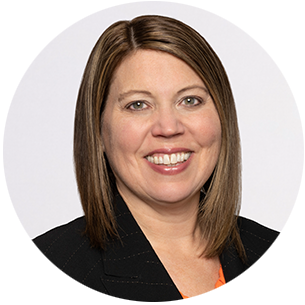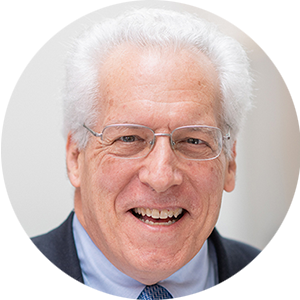Jeremy Tennenbaum, senior nonprofit strategist at Vanguard, recently sat down for an insightful conversation with Nicole Stuke, Philanthropic Advisor at Greater Horizons. The pair discuss current challenges and trends impacting philanthropy today and Jeremy shares advice and predictions for what the future of giving looks like.
Who’s Who in the Q&A?

Philanthropic Advisor Nicole Stuke works with nonprofits to help them plan for their financial future through agency funds. Nicole has worked in the nonprofit landscape for more than 20 years and is dedicated to helping organizations meet their strategic goals. Before joining Greater Horizons in 2019, Nicole worked for the American Heart Association and St. Jude Children’s Research Hospital. Nicole works closely with nonprofits to establish agency funds, a fund set up by a charity to benefit that specific charity. Agency funds allow nonprofit organizations to build long-term assets, establish a home for reserve funds, and enjoy low-cost investment options and third-party oversight of assets. Nicole also works closely with individuals and families to help them achieve their charitable goals.
 Jeremy Tennenbaum, CFA, is a senior nonprofit strategist at Vanguard and leads a team that creates thought leadership for hospitals, higher education, foundations, and other tax-exempt organizations. He writes on a wide range of issues, from spending to fundraising to improving financial health. Before joining Vanguard, Jeremy was CFO at the Altman Foundation, responsible for investments, finance, and information technology. Previously, he was CEO of Spouting Rock Consulting, and before that role, he led a single-family office for the owners of Continental Grain, in addition to investing on behalf of the company. Jeremy has held senior roles at Seagate Technology, Wellington Management Company, and Salomon Brothers Inc. He sits on the advisory board for MIT’s Sloan School of Management, where he earned a master’s degree in finance. He earned a bachelor’s degree in politics and intellectual history from Princeton University. Jeremy holds the Chartered Financial Analyst® certification and is a longtime board member and former president of the CFA Society of Philadelphia. He presently serves on the investment committee for Main Line Health.
Jeremy Tennenbaum, CFA, is a senior nonprofit strategist at Vanguard and leads a team that creates thought leadership for hospitals, higher education, foundations, and other tax-exempt organizations. He writes on a wide range of issues, from spending to fundraising to improving financial health. Before joining Vanguard, Jeremy was CFO at the Altman Foundation, responsible for investments, finance, and information technology. Previously, he was CEO of Spouting Rock Consulting, and before that role, he led a single-family office for the owners of Continental Grain, in addition to investing on behalf of the company. Jeremy has held senior roles at Seagate Technology, Wellington Management Company, and Salomon Brothers Inc. He sits on the advisory board for MIT’s Sloan School of Management, where he earned a master’s degree in finance. He earned a bachelor’s degree in politics and intellectual history from Princeton University. Jeremy holds the Chartered Financial Analyst® certification and is a longtime board member and former president of the CFA Society of Philadelphia. He presently serves on the investment committee for Main Line Health.
What are you seeing as the current trends in philanthropy?
(JT): When I was a kid, I used to do a lot of sailing, and sailors, there’s a term in sailing that strikes fear in the hearts of anybody who gets on a sailboat, which is called cross seas. That’s when you have currents that are running at angles to each other and they can turn over the most seaworthy vessel. And that’s what we’re facing now; we’re facing cross seas on the investment side, on the economic side, on the giving side.
So, let me start. Although in the United States we’re acting as if the pandemic is over, it’s still with us. Many organizations are still coping with the lingering effects of the pandemic in terms of challenges, retaining the workforce, and hiring new workforce. I think the second cross current that we’re all coping with is inflation. So inflation has two aspects that impact nonprofits. First and foremost, everybody’s cost structure is being impacted. Whether you’re looking for new space, you’re going to have to pay more on rent. You’re having to pay more for employees. And again, as many know, the nonprofit world, because we’ve never had a lot of money, has historically depended a lot on low-cost labor. And if you are going to pay people $15 an hour, that might have been acceptable pre-pandemic, now it’s going to be $20, $22, $24 an hour. So all of our nonprofits are facing challenges to their business model.
One of the reasons that inflation bothers investment people so much, it’s a silent thief. It takes the money, it takes the food out of your mouth without actually realizing it. So if you’re a fundraiser, well, guess what? The $100 contribution that you were thankful to get last year, or the $1,000 contribution, or the $10,000 contribution, well, the nominal value is still the same, but then a $100 is really only worth $92 based on what’s happened with inflation. And so in order to really keep pace, you’re going to have to raise more money.
How can donors best respond to a lot of that stress that you’re talking about?
In the past, a lot of donors, strictly donors of means, have spread money around. A wealthy family might give out $100,000 a year, but it might go to 10 or 11 different causes or areas. My suspicion, and it’s only a suspicion, is that going forward, particularly as they want to make certain that their philanthropy is having as great an impact as it could, is that people will be, instead of supporting 10 causes they might support seven or six. So the good news is that the dollar amount to each cause will be greater, the bad news is they’ll be supporting six instead of 10. What does that mean? That means, I think it’s more important than ever for nonprofits to love their donors, for nonprofits to get the message out to the donors about how important, A, how important the donors are, and B, to make it clear what the donations are going for.
I see this very clearly with my children who are millennials. I think it’s true for all demographic cohorts. I think people more and more want to make certain that their money is being put to good use by the nonprofits they give it to. What we saw the last couple of years was, that donors were voting, I wouldn’t say voting with their feet, but they were instinctively giving money to where the needs were greatest. So we saw a lot of huge increase in donations to hunger and homelessness, but a corresponding drop in donations to arts and cultural organizations, frankly most of whom were closed. I think donors were saying, well, look, they’re in suspended animation, and they’re not open now anyway. So let me give money to the homeless shelter or to the food bank.
So the question is, will that continue? Because frankly, the needs of food banks are maybe not as quite as great as they were a year ago, but they’re still pretty substantial. And the challenges food banks have because it’s costing them more money to get food and it’s going to cost them more money to hire folks to distribute the food. So I think you and I, and everybody else who’s an observer of the scene is trying to figure out, okay, are folks going to say, well, we still need to give more money to help hunger, or we’re just going to give a little bit less to arts and culture, or we’re just trying to find out what’s happening.
So how can donors put plans in place now to ensure that their favorite nonprofits are prepared for the future? Are there certain gifts such as legacy gifts, bequests, or endowments that you’re thinking about that really can change things you talked about?
Legacy giving is very much in the mind of your donors if you’re a nonprofit. So what can you do as a nonprofit? Number one, you can work with local nonprofit attorneys to make it as easy as possible for your donors to make legacy gifts. It does require a little work on your part, but put the forms on your website, because again, small nonprofits might only have one or maybe two development people. So make sure that one of those development people’s really pretty good at legacy giving because to get legacy giving, you’re not just reaching out to donors, but reaching out to that whole ecosystem, you’re reaching out to the donor’s estate planning attorneys and to their financial advisors and to their accountants.
Now on the flip side, if you are a donor, you are going to have to do a little homework. So number one, what are the causes that really mean the most to you and to your spouse? How do you intend to fund those causes with a combination of current giving and giving legacy giving? How do you know that the organization that you’re going to give to is going to be around? It’s one of the reasons we like donor-advised funds, whether done through a community foundation or done through a national, a DAF (donor-advised fund), is that it creates a vehicle that’s relatively inexpensive that allows a donor to make plans for years in advance as to where the money’s going to go.
Do you think donors are going to have to think about being able to give dollars and allocate unrestricted dollars, allocate dollars for salaries, for overhead, for supply chain issues, etc? Is that changing in your mind and are you seeing less restrictive gifts?
Again, I’m seeing a lot of cross seas, or cross currents. Well, guess what? Overhead’s an intrinsic cost for any human organization. And if the donors don’t give money to support the overhead, the organizations are going to have to figure out how to pay for the overhead someplace else. So over the last five or six years, you’ve seen more of an effort to have people, more donors, both big foundations and smaller private donors are saying fine, let me write a check. And either a certain amount will be dedicated to overhead or will tell in our donation letter or our grant letter; we will tell the organization they can use some for overhead.
Now the cross current is that donors like to be able to say, I want my money to go to this program, not to this other program. And I think increasingly as nonprofits compete for donor dollars, they’re trying to say, well, okay, here are six programs you can support, you pick them. I think what will happen is that the nonprofits will say you pick them, but guess what? Whatever program you support, X percent of that money will be going to nonprofit overhead.
If you could offer advice to both donors and nonprofits right now, what would it be?
What I would say to donors is as follows: The needs have never been greater, but with inflation, every dollar you give is going to be worth less to the recipient than it was a year ago. And so I would encourage donors to think very carefully about the organizations that mean the most to you, to your spouse, to your family. And in the past, if you’ve given to all 10 equally meritorious recipients. And if they are, maybe you want to give more to six of them and less to four. I think it probably is a sensible strategy for you to maybe focus more dollars on fewer nonprofits, knowing that you’re going to have an outsize impact on that. Now let’s flip to the nonprofit side. What we see with nonprofits, particularly small nonprofits, is as a human tendency you want to be all things to all people. Well, you can’t be all things to all people.
You’ve historically had a certain core base of donors. You have to love them even more than you’ve loved them in the past. You have to reach out to them even more than you’ve reached out to them in the past. Don’t be afraid to ask them to help you not so much with dollars, but hey, do you have a friend or relative who feels the way you do, would you be willing to ask them to give money to us? Don’t ask for names, but just ask them for their help, because again, I think historically people are very willing to give what I call nonfinancial support, just getting the word out for you. I think it’s going to be more important than ever before. Again, since the ranks of nonprofits will go down, whether we want them to, or not, for nonprofit boards to be more involved in fundraising than they’ve ever been in the past.
Is there anything else that you’d like to add, or talk about that you’re seeing right now?
I would just say it’s more important than it’s been in years for you not to run and hide, whether you’re the donor or whether you’re the nonprofit. If you’re the nonprofit you’re competing for scarce resources, and you may not like it, but that’s the reality of life. So you need to be very clear to donors, A) that you intend to survive, B), that you have a plan to get there, C), that you are very clear about what you’re going to be doing with every dollar that they give you.
I wish I had more in the way of really explicit answers, but again, I can see that we’re in an environment of cross seas. And so I can recognize the cross seas, I don’t know which of the currents are going to end up predominating. The one thing I feel fairly confident about is that we’ll see; I think people are just going to sharpen their giving lens or their giving focus. And again, I’m not saying that they’ll give less, fewer dollars, but they might give the same dollars to fewer organizations. I just think that people want to feel more in control of their giving and more confident in the organizations to whom they give.
About this Q&A:
About 10 years ago, Greater Horizons’ investment committee made the decision to convert the holdings in our investment pools to 100% passive investments. Vanguard was selected for 99% of the dollars invested. They were literally the vanguard of passive investing. Vanguard’s mission is to take a stand for all investors, to treat them fairly and to give them the best chance for investment success, which aligns succinctly with Greater Horizons’ values and mission.
Greater Horizons has two investment criteria. The first one is the fund we select must track its benchmark with very low tracking error. The second criteria is that we also look for very low expense ratios so that the vast majority of the performance of the pool accrues to the pool participants rather than the investment manager. Vanguard is truly a leader on both counts. Through this great partnership with Vanguard, we’re able to work with the institutional investor group, which created a position of senior nonprofit strategist, which Jeremy holds today.

